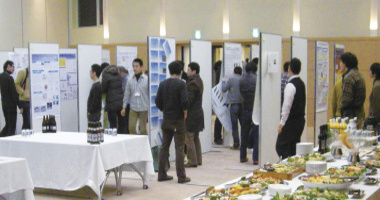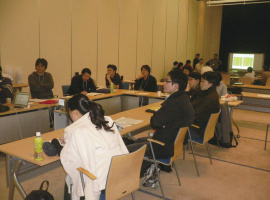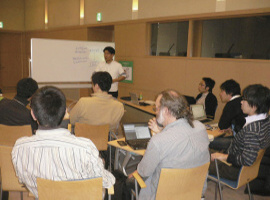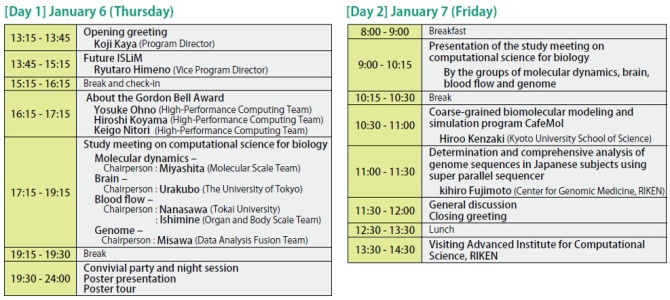
Winter School 2011 for the Integrated Simulation of Living Matter
Computational Science Research Program, RIKEN
Yasuhiro Ishimine (Organ and Body Scale WG)
The Institute of Medical Science, The University of Tokyo
Hidetoshi Urakubo (Brain and Neural WG)
Computational Science Research Program, RIKEN
Yasuhiro Sunaga (Cell Scale WG)
Computational Science Research Program, RIKEN
Gen Masumoto (High-Performance Computing Team)
Computational Science Research Program, RIKEN
Keiji Misawa (Data Analysis Fusion WG)
Computational Science Research Program, RIKEN
Hisayuki Miyashita (Molecular Scale WG)
On January 6 and 7, 2011, the Winter School 2011 for the Integrated Simulation of Living Matter in the “Research and Development of the Next- Generation Integrated Simulation of Living Matter (ISLiM)” was held. ISLiM usually consists of a Molecular Scale Team, Cell Scale Team, Organ and Body Scale Team, Data Analysis Fusion Team, Brain and Neural Team, and High- Performance Computing Team. ISLiM is developing a software to perform a numerical simulation related to life science in various spatiotemporal scales of organisms and a large scale data analysis by harnessing the full range performance of the ten quadrillion speed computer “Kei”, aimed at research leading to drug discovery and development of therapeutic methods.
This winter school was planned and managed mainly by young researchers participating in ISLiM projects, and there were 48 participants. In opening the school, Koji Kaya, a program director, made an opening speech. Next, Ryutaro Himeno, a vice program director, delivered a lecture about how to manage the future ISLiM.
In the next session, the High-Performance Computing Team consisting of experts in high-speed computation made a speech. Mr. Keigo Nitori related the episode when he received the Gordon Bell Award in the price/ performance section of SC in 2009 with a computer consisting of a GPU together with Mr. Hamada, Nagasaki University. Mr. Yosuke Ohno explained the review process of the Gordon Bell Award from the experience when he became a finalist for the Gordon Bell Award. Also, Mr. Hiroshi Koyama in the High-Performance Computing Team spoke harshly about the implementation of high-performance computing with “Kei.”
The next section was held by dividing participants into 4 subcommittees. In each subcommittee, recent research articles were selected from the 4 fields of molecular dynamics, blood flow, brain and genome, and brainstorming was done based on the articles. In order to climb over a fence among teams that usually cannot meet together, members were allocated to each subcommittee so as to crossover from their usual teams. An active discussion was held from the viewpoint of high-performance computing.
Thereafter, a convivial party was held, a poster presentation was made, and we had the opportunity to hear a presentation of the research carried out by all members. The discussion continued hotly until the time for the room expired at midnight.
First thing in the morning on the next day, the discussions of the subcommittees were summarized and presented in about 15 minutes. In the subcommittee on molecular dynamics, advances in protein research considering the cellular environment were discussed by taking virus capsid protein as an example. In the subcommittee on blood flow, thrombus formation was considered as a main theme of simulation by including platelets in simulation, aiming at infarction utilizing thrombus formation. In the subcommittee on the brain, the real-time behavior of animals in the cat family, for example the lion, was considered, and real-time processing of multi-channel data about brain activity, and construction and its realtime processing in an internal model including a neural network, were discussed. Moreover, there was a joke that they should search for a place to keep lions on the site of “Kei.” In the subcommittee on the genome, an algorithm to search for a place where only incorrect consistency among genome sequences can be obtained due to mutation was discussed. All the subcommittees aimed at close collaboration with the High-Performance Computing Team as to the method of computation.
In the last section, Mr. Hiroo Kenzaki, Kyoto University, talked about the “coarse-grained biomolecular modeling and simulation program CafeMol” disclosed as one of the first runner softwares of ISLiM at the end of last year (http://www.cafemol.org/). Moreover, Mr. Akihiro Fujimoto, Center for Genomic Medicine, delivered a lecture with the title “Determination and comprehensive analysis of genome sequences in Japanese subjects using a super parallel sequencer” published in the journal, NatureGenetics. This research was taken up in several newspapers.

|

|
|
We ardently hope that the communication in this winter school will bring
out the performance of “Kei”, and lead to drug discovery and development
of therapeutic methods. At the end of the winter school, we visited the
facility of the ten quadrillion speed computer “Kei.” There may be no space
for keeping lions. |

|
Program of Winter School 2011
for the Integrated Simulation of Living Matter

BioSupercomputing Newsletter Vol.4
- SPECIAL INTERVIEW
- In order to change from observation-type medical practice focusing on experience to prediction-type medical practice to construct the base of theoretical medicine
Professor, Department of Internal Medicine (Cardiovascular Medicine), Director of the Metabolic Disease Research Center, Bio-Research Medical Center, Tokai University Graduate School of Medicine, and Director, Department of Metabolic System Medicine, Tokai University General Medical Laboratory Shinya Goto - It is expected that new possibilities in nutrition science and health control will be opened up
by simulation science
EXECUTIVE PROFESSIONAL Health infomatics DEPT., Ajinomoto Co., Inc. Toshihiko Ando
- Report on Research
- The functions of a multidrug discharging transporter were verified by coarse graining molecular simulation (Molecular Scale WG)
Graduate School of Science, Kyoto University Shoji Takada / Xin-Qiu Yao / Hiroo Kenzaki - Cell simulation considering time-space (Cell Scale WG)
Computational Science Research Program, RIKEN Yasuhiro Sunaga - Development of HIFU simulator for non-invasive treatment with high-intensity focused ultrasound (Organ and Body Scale WG)
VCAD System Research Program, RIKEN Kohei Okita - PLATO: Platform for a collaborative brain system modeling toward development of large scale mathematical model.(Brain and Neural WG)
①Computational Science Research Program, RIKEN
②Brain Science Institute, RIKEN
Keiichiro Inagaki①/ Takayuki Kannon②/ Nilton L. Kamiji②/ Koji Makimura②/ Shiro Usui ①②
- Report
- Report on the workshop in BMB2011 (Joint Meeting of the 33rd Congress of the Molecular Biology Society of Japan and the 83th Congress of the Japanese Biochemical Society)
- Winter School 2011 for the Integrated Simulation of Living Matter
Computational Science Research Program, RIKEN Yasuhiro Ishimine (Organ and Body Scale WG)
The Institute of Medical Science, The University of Tokyo Hidetoshi Urakubo (Brain and Neural WG)
Computational Science Research Program, RIKEN Yasuhiro Sunaga (Cell Scale WG)
Computational Science Research Program, RIKEN Gen Masumoto (High-Performance Computing Team)
Computational Science Research Program, RIKEN Keiji Misawa (Data Analysis Fusion WG)
Computational Science Research Program, RIKEN Hisayuki Miyashita (Molecular Scale WG) - Winter School 2011 for the Integrated Simulation of Living Matter
